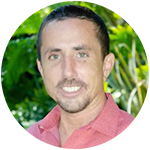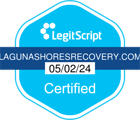Fentanyl Addiction Treatment in California
At Laguna Shores Recovery in Dana Point, California, we offer a comprehensive fentanyl rehab program as part of our drug and alcohol treatment programs. We provide multiple payment options and accept many insurance plans to make care accessible. The cost of fentanyl rehab at our facility is often more affordable than residential treatment, and we offer flexible payment and insurance reimbursement options to help patients manage expenses.
Our Orange County fentanyl treatment center helps individuals and families heal from addiction. Rehab offers the structure, support, and safety needed to build a healthier life free from opioids. The benefits of fentanyl rehab include improved safety, ongoing support, stability, and accountability, all of which are essential for successful recovery. If you or a loved one is struggling with fentanyl addiction, we’re here to help you take the first step toward recovery.

Fentanyl is a potent synthetic opioid about 50 times stronger than heroin and 100 times stronger than morphine. While pharmaceutical-grade fentanyl can safely treat severe pain when prescribed, misuse—especially of illicitly manufactured fentanyl (IMF)—often leads to addiction and overdose. Fentanyl is also highly addictive, making it especially dangerous and increasing the risk of dependence and abuse.
Because of its extreme potency, even two milligrams can be fatal. The risk is even higher when fentanyl is combined with other drugs and substances like heroin or cocaine, a common practice that increases the chance of accidental overdose. Fentanyl also slows breathing, which can quickly lead to hypoxia, coma, brain damage, or death—even if the person appears to be asleep.
The CDC estimates that in 2021, more than 107,000 Americans died from drug overdoses, and 67% involved fentanyl. These alarming numbers highlight the urgent need for prevention, education, and treatment.
Fortunately, naloxone can reverse fentanyl overdoses by displacing opioids from brain receptors, though multiple doses may be required due to its strength. Long-term recovery often involves medication-assisted treatment (MAT) with options like Suboxone, along with counseling and support programs.
At Laguna Shores Recovery in Dana Point, California, we provide comprehensive fentanyl rehab programs that address both the physical and psychological effects of addiction, offering hope and a path toward lasting recovery.
Misconceptions About Fentanyl
Here’s how California data dispels common myths:
- Fentanyl is a major driver of overdose deaths in California. In 2020, nearly 72% (3,946 of 5,502) of opioid overdose deaths involved fentanyl.
- Overdose rates are climbing rapidly. For example, Orange County saw opioid overdose death rates nearly triple between 2017 and 2021.
- Even single exposures to fentanyl are dangerous; its impact on breathing can lead to hypoxia, coma, brain damage, or death if untreated.
Combining national and state data makes clear: fentanyl abuse is not a peripheral issue—it’s central to the overdose crisis and demands serious prevention, treatment, and public awareness.
How Does Fentanyl Affect the Brain and Body?
- Intense cravings: Dependence makes it difficult to focus on eating, sleeping, or daily tasks without the drug.
- Compulsion to use: Physical and psychological urges lead individuals to keep using despite harmful consequences.
- Loss of control: Users take larger amounts as tolerance grows, increasing overdose risk.
Fentanyl alters dopamine production over time, leaving the brain unable to regulate mood naturally. This can result in depression, disrupted sleep, and severe withdrawal when use stops.
Fentanyl can be identified through blood tests or with fentanyl test strips. Because it is odorless and tasteless, people often unknowingly consume it when mixed with other drugs. Contrary to myths, fentanyl is not absorbed through casual skin contact, so it is safe to assist someone experiencing an overdose.
Causes of Fentanyl Addiction
- Prescribed for severe or chronic pain when other opioids fail.
- Rapidly builds tolerance and dependence, causing withdrawal when reduced or stopped.
- Drives ongoing use to avoid painful withdrawal symptoms.
- Stress, anxiety, depression, or trauma increase vulnerability.
- Fentanyl provides temporary emotional relief, reinforcing repeated use.
- Mental health challenges, including mental health disorders such as depression and anxiety, often fuel the cycle of addiction. It is important to address co-occurring disorders—when substance use disorder and other mental health disorders are present together—to improve recovery outcomes.
- Early exposure to substance use or a family history of addiction.
- Peer pressure and easy access to fentanyl or other opioids.
- Recreational or medical use can quickly progress to dependency.
By addressing these root causes, treatment programs can provide a comprehensive approach that tackles dependence, mental health, and environmental triggers—helping individuals break free from fentanyl addiction.
Be Brave. Get Help.
Signs, Symptoms, and Side Effects of Fentanyl Addiction
- Extreme drowsiness, “nodding off,” or slowed speech
- Morning withdrawal symptoms such as nausea, shaking, or sweating
- Misusing prescriptions (taking higher doses, crushing, or snorting pills)
- Risky or illegal behaviors like stealing prescriptions or “doctor shopping”
- Secretive behavior, isolation, or lying about drug use
- Dizziness or lightheadedness
- Dry mouth
- Severe constipation
- Itching or hives
- Nausea, vomiting, or loss of appetite
- Headaches or vision problems
- Shaking or tremors
- Hallucinations
- Suppressed breathing
Prolonged use can lead to serious health consequences, including:
- Collapsed veins and abscesses
- Heart infections (endocarditis)
- Chronic constipation and stomach cramps
- Respiratory depression
- Liver or kidney damage
- Pneumonia
- Death
Because fentanyl rapidly builds tolerance and dependence, quitting without professional help is extremely difficult. Effective treatment programs address both the short- and long-term effects of fentanyl use to support safe, lasting recovery.
Fentanyl Withdrawal and Overdose Risks
When fentanyl use is reduced or stopped, the body goes into withdrawal. Common symptoms include:
- Muscle pain and body aches
- Insomnia or restless sleep
- Diarrhea
- Uncontrolled leg movements
- Intense cravings
These symptoms often drive individuals back to use, reinforcing the cycle of addiction. Medical detox is the safest way to manage fentanyl withdrawal.
A fentanyl overdose can be fatal within minutes due to slowed or stopped breathing. Warning signs include:
- Pinpoint pupils
- Loss of consciousness
- Choking or gurgling sounds
- Vomiting
- Limp or unresponsive body
- Cold, clammy, or discolored skin
Illicit fentanyl is frequently mixed with heroin, cocaine, or counterfeit pills, increasing the risk of accidental overdose.
If you suspect a fentanyl overdose:
- Call 911 immediately.
- Administer naloxone (Narcan) if available.
- Keep the person awake and breathing.
- Lay them on their side to prevent choking.
- Stay until emergency responders arrive.
Naloxone can reverse an opioid overdose by blocking fentanyl from brain receptors, often restoring breathing within minutes. However, because fentanyl can outlast naloxone in the body, multiple doses may be required, and medical care is still essential. Many states allow naloxone to be purchased without a prescription, making it a life-saving tool for families and communities affected by fentanyl addiction.
Fentanyl Addiction Treatment in California
Our fentanyl addiction treatment center integrates proven therapies such as:
- Cognitive-behavioral therapy (CBT) and dialectical behavior therapy (DBT) are used to build healthy coping skills.
- Group therapy for peer support and accountability.
- Family therapy to supplement individual substance abuse treatment
Our skilled team, including doctors who develop personalized detox and treatment plans and therapists who support ongoing mental health recovery, creates individualized treatment plans and offers 24/7 support, ensuring clients feel safe and supported throughout their recovery journey.
- Medical Detox: The first step in recovery, allowing individuals to safely withdraw from fentanyl under medical supervision.
- Inpatient Treatment: Residential care with 24/7 support, therapy sessions, and medical monitoring.
- Outpatient Treatment: Flexible programs allowing individuals to continue work or family responsibilities while receiving care.
- Intensive Outpatient Program (IOP): A higher level of outpatient care with multiple therapy sessions and case management each week.
- Medication-Assisted Treatment (MAT): Combines FDA-approved medications with therapy to ease withdrawal and reduce relapse risk.
To support mind-body healing, we offer holistic therapies such as yoga, meditation, art therapy, and equine-assisted therapy, which enhance emotional resilience and overall well-being.
Many individuals struggling with fentanyl addiction also face mental health disorders such as anxiety or depression. Our dual diagnosis program addresses both substance use and co-occurring conditions, helping clients stabilize their mental health while pursuing sobriety. This comprehensive approach increases the likelihood of a successful recovery.
Choosing the right fentanyl addiction treatment program is crucial for long-term success. At Laguna Shores, our comprehensive services, compassionate staff, and supportive environment provide the tools needed to break free from fentanyl addiction and build a healthier future.
Importance of Aftercare in Fentanyl Addiction Recovery
A strong aftercare plan is tailored to each individual and may include:
- Continued therapy and counseling to address triggers and maintain coping skills.
- Support groups such as 12-step meetings, SMART Recovery, or group counseling for accountability and connection.
- Medication management (MAT) to help reduce cravings and prevent relapse.
- Sober living homes provide structured, drug-free environments.
- Alumni programs that keep individuals connected to their treatment center and peers in recovery.
- Ongoing mental health care for co-occurring conditions like anxiety or depression.
These resources help individuals manage cravings, avoid relapse, and build healthy routines that support long-term recovery. Staying engaged with aftercare ensures stability, encouragement, and accountability—key factors in maintaining a fulfilling, substance-free life.
Frequently Asked Questions About Fentanyl Addiction and Treatment
Can you overdose on fentanyl just by touching it? No. Fentanyl is not absorbed through casual skin contact. It must be ingested, injected, or inhaled to cause an overdose. It is safe to assist someone who has overdosed if you call 911 and use naloxone if available.
What are the first signs of fentanyl addiction? Early signs include extreme drowsiness, slowed speech, secretive behavior, misuse of prescriptions, and withdrawal symptoms such as nausea or shaking in the morning.
How long does fentanyl withdrawal last? Fentanyl withdrawal typically begins within a few hours of the last dose and can last 5–10 days. Symptoms include muscle pain, insomnia, diarrhea, and intense cravings. Medical detox helps manage these symptoms safely.
What is the most effective treatment for fentanyl addiction? The most effective approach combines medical detox, behavioral therapies like CBT or DBT, and medication-assisted treatment (MAT) with medications such as buprenorphine or methadone. Aftercare programs and dual diagnosis treatment also improve long-term recovery outcomes.
Can naloxone reverse a fentanyl overdose? Yes. Naloxone (Narcan) can reverse fentanyl overdoses by displacing opioids from brain receptors. However, due to fentanyl’s potency, multiple doses may be required, and emergency medical care is still necessary.
Does insurance cover fentanyl rehab in California? Many insurance plans cover part or all of fentanyl addiction treatment, including detox, inpatient, and outpatient care. At Laguna Shores Recovery, we accept most major insurance providers and offer payment options to make treatment accessible.
What happens after completing a fentanyl rehab program? Recovery continues with aftercare services such as outpatient therapy, support groups, sober living, alumni programs, and ongoing mental health care. Aftercare is essential for relapse prevention and long-term sobriety.
When is fentanyl prescribed by doctors? Fentanyl is typically prescribed for severe pain that cannot be managed by other opioids, especially after surgery or major medical procedures. Its use after surgery is closely monitored by medical professionals to prevent misuse and ensure patient safety.
Be Brave. Get Help.
Our Fentanyl Addiction Treatment Program Can Help You Recover
You don’t have to face addiction alone. Contact us today to learn more about our fentanyl rehab programs and take the first step toward lasting recovery, healing, and a brighter future.


 Matthew Beck B.A, M.A, LMFT
Matthew Beck B.A, M.A, LMFT 


